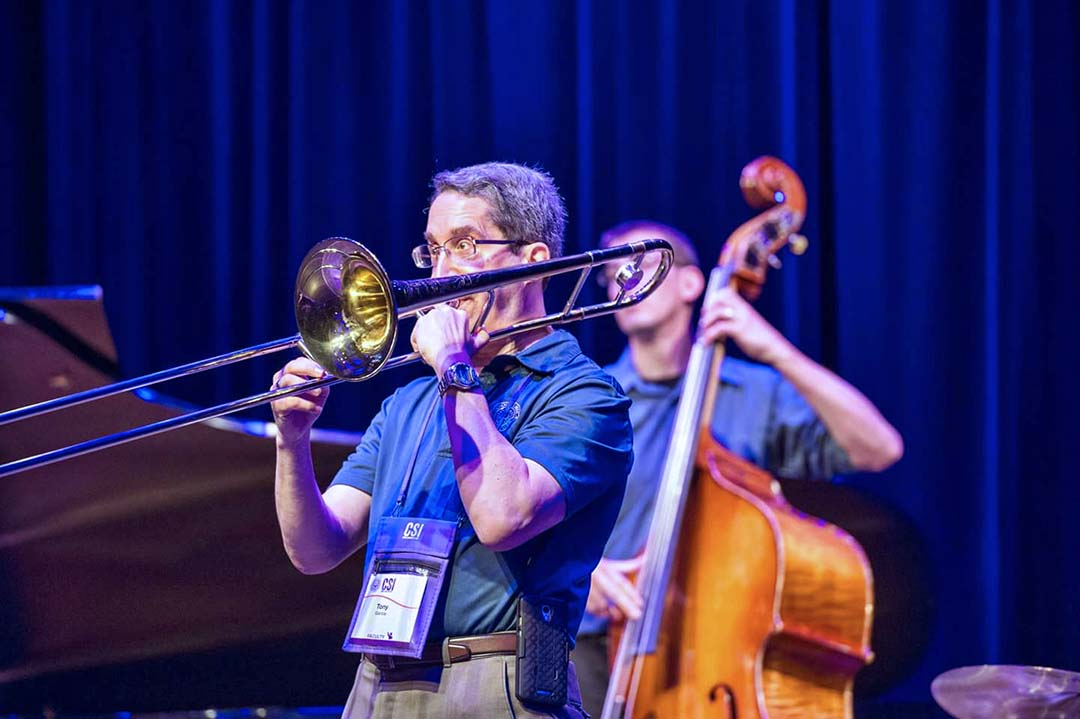 |
Antonio García solos at the Conn-Selmer Institute. |
|
This article is copyright 2022 by Antonio J. García and originally was published in Down Beat, Vol. 89, No. 12, December 2022. It is used by permission of the author and, as needed, the publication. Some text variations may occur between the print version and that below. All international rights remain reserved; it is not for further reproduction without written consent. |
"Giant Steps" as Shorter Steps
Masterclass
by Antonio J. García
 |
Antonio García solos at the Conn-Selmer Institute. |
(For your own ease of study off-line,
click here to download a printable PDF collection of the chord changes in C Treble, C Bass, Bb, Eb,
and F, plus the musical examples in C;
and click here to download the two mp3 files of the audio for the examples. You can, however, see all the concert C examples below on this web page.)
I’m always looking for ways to bridge students’ gap between improvising over the more common cycle-of-fifth standard tunes and “Giant Steps,” with its unsettling newness of the “up a minor third, down a fifth” chord progressions that frequent John Coltrane’s landmark composition (Example 1):
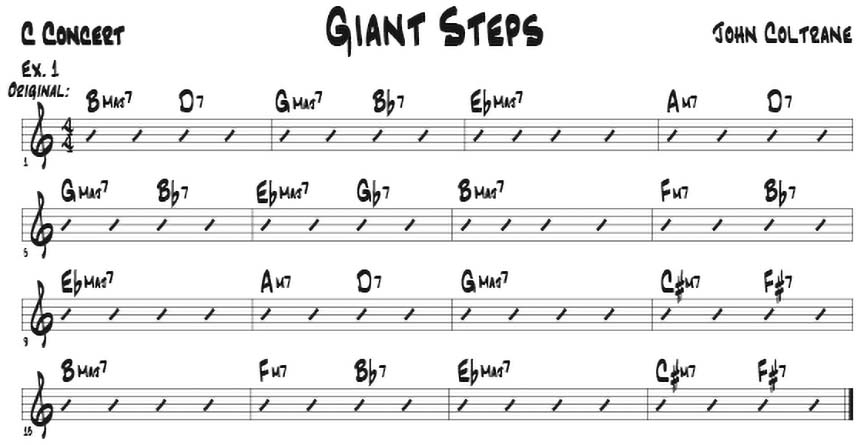 |
(Click on the above musical example to hear the related audio.)
So, as in life, I look for what is shared in common! That can lead to greater successes and often dwarfs what divides us.
My friend and colleague Neil Gonsalves (director of the Centre for Jazz and Popular Music at the University of KwaZulu-Natal in Durban, South Africa) composed his own tune-variation, “Little Giants,” posting it online and inviting others to solo over it and post their recordings. His resulting progression of descending chords, though not compatible with Coltrane’s own melody, frequently substituted minor chords for dominants. To explore it, visit <https://tinyurl.com/4a7hewen>; see #littlegiants on Facebook; or look up Gonsalves’ name and “Little Giants” on Facebook or YouTube for a link to his Google folder of backing-track plus lead sheets in various keys.
Neil’s progression replaced Coltrane’s opening Bmaj7 D7 Gmaj7 Bb7 Ebmaj7 with Bmaj7 Bbm11 Abmaj7 Gm11 Fmaj7. The pattern of major, minor, major, minor, major must have resonated with me, though the arrival-chord was not Coltrane’s Ebmaj7.
Later, while mentoring a student in a subsequent lesson, I recognized a different tonal organization for “Giant Steps” that I don’t recall encountering previously. I can’t imagine I’m the first one to conceive of it; but since this uncommon approach has since greatly assisted performances by improvisors newer to the tune, I’m outlining it here for you and your own students to share and explore.
Two for Five, and Five for Two
The original opening phrase of “Giant Steps” quickly hits you with its novel cycle: Bmaj7 D7 Gmaj7 Bb7 Ebmaj7. The ingenuity of third-leaps upward (instead of fifths downward), plus shifting key-centers mid-measure (instead of the more-typical barline-locale) can be disorienting, especially if transposing the tune to different keys.
While ii-V progressions may seem more familiar, I regularly remind my students that when it comes to chords, “any ii can have its V, and any V can have its ii.” Both chords exist in the one key, one family; and only one tone of emphasis needs to change above the bass-tone for a ii7 chord to become a V9 chord (Example 2, shown in G):
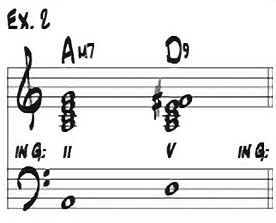 |
If you choose not to shift that seventh of the ii chord to the third of the V chord, then the ii7 chord becomes instead a V9sus (Example 3), still very much in the same key:
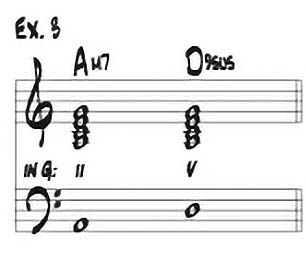 |
So if you were to solo over a modal tune of all minor chords, you could still approach soloing as if their related V-chords also follow them. And over a tune of all dominant chords, such as a basic blues, you could consider adding in their respective preceding minor ii chords (as demonstrated in so many bebop blues tunes).
That established, what happens if we replace each dominant V chord in the first three bars of this four-measure “Giant Steps” progression with instead its related ii chord? We’ll arrive at a descending-bass pattern that is more linear throughout the phrase: descending whole-steps representing the same key centers as the original chords. As you can see in Example 4, Bmaj7 D7 Gmaj7 Bb7 Ebmaj7 becomes Bmaj7 Am7 Gmaj7 Fm7 Ebmaj7:
 |
Now we have a memorable linear chord progression (B A G F Eb)—rather than the original based on leaps (B D G Bb Eb); and the chords descend in consistent whole-steps. Moreover, we have alternating chord-qualities (major, minor, major, minor, major).
Suspending Disbelief
The sonic effect, if Coltrane’s bass-tones are preserved, is merely as if we’d altered the original D7 to D7sus (Am7/D) and Bb7 to Bb7sus (Fm7/Bb), as shown in Example 5:
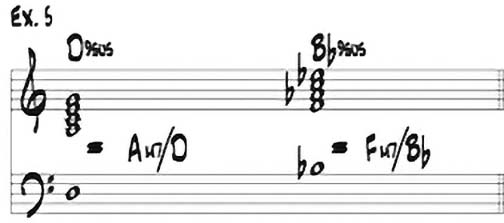 |
While I’m not suggesting Am7 and Fm7 as necessarily ideal chord substitutions for comping at these locales, they are indeed compatible with Coltrane’s melody. For a secondary pianist such as myself, they do increase the ease of comping. And if I further choose to conceive of the Am7 and Fm7 instead as Am6 and Fm6, I’ve then voiced over Coltrane’s bass tones a D9 and Bb9 (Example 6) corresponding with the original V chords in the second half of Coltrane’s first two measures:
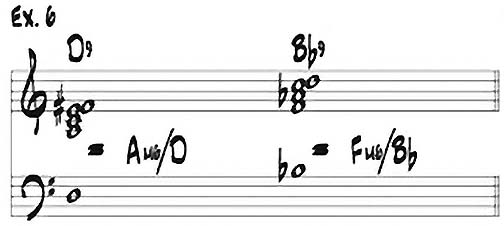 |
More importantly, this new flow of alternating major and minor qualities, along with their descending roots, preserves the key centers of the tune while providing a linear-thinker harmonic steps that are not so giant—a perspective that is initially easier to process.
Complete the phrase with the dominant chord originally found in the fourth bar; and we find that though its quality is indeed dominant, the bass still descends, now by half-step, from Ebmaj7 to the fourth measure’s D7 (Example 7): Bmaj7 Am7 Gmaj7 Fm7 Ebmaj7 D7.
 |
Following a cycle-of-fifth drop from measure four to five, the next four measures then transform into a harmonic pattern parallel to the first four, just a major third lower, becoming Gmaj7 Fm7 Ebmaj7 C#m7 Bmaj7 Bb7 (Example 8).
 |
The Easy Part
The last eight bars are considered simpler by most musicians since no minor-third chord-leaps ensue. Yet we can simplify them further with the oft-used concept of eliminating the ii chords and focusing more on the V’s. This creates four pairs of chords that descend by half-step while shifting quality from major to dominant and back—each pair descending a fifth to the next pair. Thus the third four-bar phrase becomes Ebmaj7 D7 Gmaj7 F#7, and the fourth phrase Bmaj7 Bb7 Ebmaj7 F#7 (Example 9):
 |
By doing so, we have created a minor-third leap-progression in the final two bars (Ebmaj7 F#7). If you prefer to eliminate all minor-third progressions, then in the final bar choose the original C#m7 instead of the original F#7 (thus the ii for its V, Example 10), resulting in a descending whole-step movement from the preceding Ebmaj7 to the C#m7 (Bmaj7 Bb7 Ebmaj7 C#m7) and another one proceeding from that C#m7 to the Bmaj7 at the top of the next chorus of the tune:
 |
Shorter Steps
John Coltrane’s original chords and melody display not only musical brilliance but mathematical elegance. The “shorter steps” above, derived from the original, have their own elegance, arriving at the 16-bar progression shown in totality within Example 11 that a budding soloist could visualize over the original comping:
 |
(Click on the above musical example to hear the related audio.)
If you find “Giant Steps” a challenge, give this alternate look a try. Share it with others, and then work back towards mastering Coltrane’s original changes. Remember that a speedy tempo is not required to enjoy the beauty of these harmonies! If you’ve already mastered his progressions, you may find—as some of my more advanced students have—that soloing with these mostly stepwise chords in mind can open up some new perspectives for your improvisations.
Find PDFs of these chord progressions printed in keys of C, Bb, Eb, and F plus a play-along track archived with this article.
(As noted above: for your own ease of study off-line,
click here to download a printable PDF collection of the chord changes in C Treble, C Bass, Bb, Eb,
and F, plus the musical examples in C;
and click here to download the two mp3 files of the audio for the examples. You can, however, see all the concert C examples above on this web page.)
_ _ _ _ _ _ _ _ _ _ _ _ _ _ _
Antonio J. García is a Professor Emeritus and former Director of Jazz Studies at Virginia Commonwealth University, where he directed the Jazz Orchestra I; instructed Applied Jazz Trombone, Small Jazz Ensemble, Jazz Pedagogy, Music Industry, and various jazz courses; founded a B.A. Music Business Emphasis (for which he initially served as Coordinator); and directed the Greater Richmond High School Jazz Band. An alumnus of the Eastman School of Music and of Loyola University of the South, he has received commissions for jazz, symphonic, chamber, film, and solo works—instrumental and vocal—including grants from Meet The Composer, The Commission Project, The Thelonious Monk Institute, and regional arts councils. His music has aired internationally and has been performed by such artists as Sheila Jordan, Arturo Sandoval, Jim Pugh, Denis DiBlasio, James Moody, and Nick Brignola. Composition/arrangement honors include IAJE (jazz band), ASCAP (orchestral), and Billboard Magazine (pop songwriting). His works have been published by Kjos Music, Hal Leonard, Kendor Music, Doug Beach Music, ejazzlines, Walrus, UNC Jazz Press, Three-Two Music Publications, Potenza Music, and his own garciamusic.com, with five recorded on CDs by Rob Parton’s JazzTech Big Band (Sea Breeze and ROPA JAZZ). His scores for independent films have screened across the U.S. and in Italy, Macedonia, Uganda, Australia, Colombia, India, Germany, Brazil, Hong Kong, Mexico, Israel, Taiwan, and the United Kingdom. He has fundraised $5.5 million in external gift pledges for the VCU Jazz Program, with hundreds of thousands of dollars already in hand.
A Bach/Selmer trombone clinician, Mr. García serves as the jazz clinician for The Conn-Selmer Institute. He has freelanced as trombonist, bass trombonist, or pianist with over 70 nationally renowned artists, including Ella Fitzgerald, George Shearing, Mel Tormé, Doc Severinsen, Louie Bellson, Dave Brubeck, and Phil Collins—and has performed at the Montreux, Nice, North Sea, Pori (Finland), New Orleans, and Chicago Jazz Festivals. He has produced recordings or broadcasts of such artists as Wynton Marsalis, Jim Pugh, Dave Taylor, Susannah McCorkle, Sir Roland Hanna, and the JazzTech Big Band and is the bass trombonist on Phil Collins’ CD “A Hot Night in Paris” (Atlantic) and DVD “Phil Collins: Finally...The First Farewell Tour” (Warner Music). An avid scat-singer, he has performed vocally with jazz bands, jazz choirs, and computer-generated sounds. He is also a member of the National Academy of Recording Arts & Sciences (NARAS). A New Orleans native, he also performed there with such local artists as Pete Fountain, Ronnie Kole, Irma Thomas, and Al Hirt.
Mr. García is a Research Faculty member at The University of KwaZulu-Natal (Durban, South Africa) and the Associate Jazz Editor of the International Trombone Association Journal. He has served as a Network Expert (for Improvisation Materials), President’s Advisory Council member, and Editorial Advisory Board member for the Jazz Education Network . His newest book, Jazz Improvisation: Practical Approaches to Grading (Meredith Music), explores avenues for creating structures that correspond to course objectives. His book Cutting the Changes: Jazz Improvisation via Key Centers (Kjos Music) offers musicians of all ages the opportunity to improvise over standard tunes using just their major scales. He is Co-Editor and Contributing Author of Teaching Jazz: A Course of Study (published by NAfME), authored a chapter within Rehearsing The Jazz Band and The Jazzer’s Cookbook (published by Meredith Music), and contributed to Peter Erskine and Dave Black’s The Musician's Lifeline (Alfred). Within the International Association for Jazz Education he served as Editor of the Jazz Education Journal, President of IAJE-IL, International Co-Chair for Curriculum and for Vocal/Instrumental Integration, and Chicago Host Coordinator for the 1997 Conference. He served on the Illinois Coalition for Music Education coordinating committee, worked with the Illinois and Chicago Public Schools to develop standards for multi-cultural music education, and received a curricular grant from the Council for Basic Education. He has also served as Director of IMEA’s All-State Jazz Choir and Combo and of similar ensembles outside of Illinois. He is the only individual to have directed all three genres of Illinois All-State jazz ensembles—combo, vocal jazz choir, and big band—and is the recipient of the Illinois Music Educators Association’s 2001 Distinguished Service Award.
Regarding Jazz Improvisation: Practical Approaches to Grading, Darius Brubeck says, "How one grades turns out to be a contentious philosophical problem with a surprisingly wide spectrum of responses. García has produced a lucidly written, probing, analytical, and ultimately practical resource for professional jazz educators, replete with valuable ideas, advice, and copious references." Jamey Aebersold offers, "This book should be mandatory reading for all graduating music ed students." Janis Stockhouse states, "Groundbreaking. The comprehensive amount of material García has gathered from leaders in jazz education is impressive in itself. Plus, the veteran educator then presents his own synthesis of the material into a method of teaching and evaluating jazz improvisation that is fresh, practical, and inspiring!" And Dr. Ron McCurdy suggests, "This method will aid in the quality of teaching and learning of jazz improvisation worldwide."
About Cutting the Changes, saxophonist David Liebman states, “This book is perfect for the beginning to intermediate improviser who may be daunted by the multitude of chord changes found in most standard material. Here is a path through the technical chord-change jungle.” Says vocalist Sunny Wilkinson, “The concept is simple, the explanation detailed, the rewards immediate. It’s very singer-friendly.” Adds jazz-education legend Jamey Aebersold, “Tony’s wealth of jazz knowledge allows you to understand and apply his concepts without having to know a lot of theory and harmony. Cutting the Changes allows music educators to present jazz improvisation to many students who would normally be scared of trying.”
Of his jazz curricular work, Standard of Excellence states: “Antonio García has developed a series of Scope and Sequence of Instruction charts to provide a structure that will ensure academic integrity in jazz education.” Wynton Marsalis emphasizes: “Eight key categories meet the challenge of teaching what is historically an oral and aural tradition. All are important ingredients in the recipe.” The Chicago Tribune has highlighted García’s “splendid solos...virtuosity and musicianship...ingenious scoring...shrewd arrangements...exotic orchestral colors, witty riffs, and gloriously uninhibited splashes of dissonance...translucent textures and elegant voicing” and cited him as “a nationally noted jazz artist/educator...one of the most prominent young music educators in the country.” Down Beat has recognized his “knowing solo work on trombone” and “first-class writing of special interest.” The Jazz Report has written about the “talented trombonist,” and Cadence noted his “hauntingly lovely” composing as well as CD production “recommended without any qualifications whatsoever.” Phil Collins has said simply, “He can be in my band whenever he wants.” García is also the subject of an extensive interview within Bonanza: Insights and Wisdom from Professional Jazz Trombonists (Advance Music), profiled along with such artists as Bill Watrous, Mike Davis, Bill Reichenbach, Wayne Andre, John Fedchock, Conrad Herwig, Steve Turre, Jim Pugh, and Ed Neumeister.
The Secretary of the Board of The Midwest Clinic and a past Advisory Board member of the Brubeck Institute, Mr. García has adjudicated festivals and presented clinics in Canada, Europe, Australia, The Middle East, and South Africa, including creativity workshops for Motorola, Inc.’s international management executives. The partnership he created between VCU Jazz and the Centre for Jazz and Popular Music at the University of KwaZulu-Natal merited the 2013 VCU Community Engagement Award for Research. He has served as adjudicator for the International Trombone Association’s Frank Rosolino, Carl Fontana, and Rath Jazz Trombone Scholarship competitions and the Kai Winding Jazz Trombone Ensemble competition and has been asked to serve on Arts Midwest’s “Midwest Jazz Masters” panel and the Virginia Commission for the Arts “Artist Fellowship in Music Composition” panel. He was published within the inaugural edition of Jazz Education in Research and Practice and has been repeatedly published in Down Beat; JAZZed; Jazz Improv; Music, Inc.; The International Musician; The Instrumentalist; and the journals of NAfME, IAJE, ITA, American Orff-Schulwerk Association, Percussive Arts Society, Arts Midwest, Illinois Music Educators Association, and Illinois Association of School Boards. Previous to VCU, he served as Associate Professor and Coordinator of Combos at Northwestern University, where he taught jazz and integrated arts, was Jazz Coordinator for the National High School Music Institute, and for four years directed the Vocal Jazz Ensemble. Formerly the Coordinator of Jazz Studies at Northern Illinois University, he was selected by students and faculty there as the recipient of a 1992 “Excellence in Undergraduate Teaching” award and nominated as its candidate for 1992 CASE “U.S. Professor of the Year” (one of 434 nationwide). He is recipient of the VCU School of the Artsí 2015 Faculty Award of Excellence for his teaching, research, and service and in 2021 was inducted into the Conn-Selmer Institute Hall of Fame. Visit his web site at <www.garciamusic.com>.
If you entered this page via a
search engine and would like to visit more of this site,